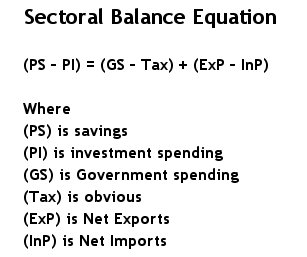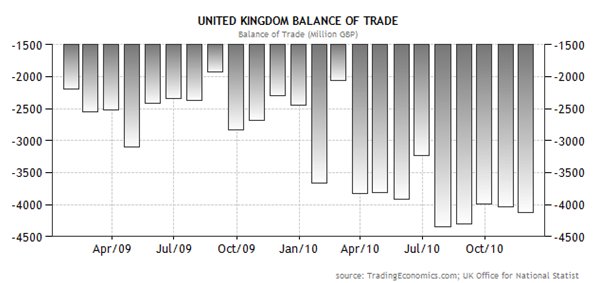I note today that the PM has announced the introduction of a flood levy, some policy changes and cuts of $2.8 billion dollars in government spending including a cut of the national rent assistance scheme. That last point is something I want to discuss in a future post because it will have some interesting effects on housing. All of these changes are yet to go through parliament, so there is sure to be some cringe-worthy exchanges while it does.
Today however I want to talk about this in a broader macroeconomic context.
You may not know that much about economics, and possibly even less about macro-economics. But if there is one formula you should know, it is the equation for sectoral balances.

Don’t get overwhelmed by the look of it. What it basically says is that there is a direct and unbreakable relationship between the government budget balance, the national trade balance and the private sector budget balance.
So what! Why is that important?
Well what it also tells you is that total change in private savings over a period are equal to private investment plus the government budget balance plus net exports over that period, and that this is always true. Although at first this formula may seem relatively unimportant, once you understand its consequences it becomes very powerful. Here is the reason.
If in an accounting period there is a trade deficit and a government budget surplus then there MUST be a private sector deficit. By private sector deficit I mean a period where there is a net loss of savings from the private sector. If this situation continues for a period of time then it leads to increasing indebtedness.
The reason this is formula is so powerful is that it allows you to make a very quick analysis about whether macro-economic decisions actually make sense and, at a high level, determine the likely outcomes of those decisions. That does not mean that this is the “magic” formula, because there may exist some other compensating factors in the economy that you are unaware of, but it certainly is a good place to start.
There are a number of recent examples of where you could have applied this formula and taken a fairly accurate guesstimate of the economic outcomes. As the unconventional economist posted yesterday, the UK has “surprisingly” double dipped. Yet if you understood sectoral balance you would have known that this outcome was somewhat inevitable with the UK economy in the state it is in.
Take a look at the balance of trade figures for the UK.

With the private sector economy already struggling the UK government decided to cut government spending. With no offsetting rise in the balance of trade ( in fact those figures are getting worse ) then the only possible outcome is that the private sector is forced to de-save.
In an economy that is already floundering and already has large private sector debt the likely outcome is that as people feel themselves getting poorer they will stop spending, attempt to save more and pay down debt.
This inevitably drives down consumption which leads to failing businesses. Unemployment then rises and surprise surprise the GDP starts to fall. We must note however that the UK figures were also weather affected so the real number may not be quite a bad as it looks. But don’t worry, the government put VAT up by 2.5% this month so they will get there soon enough.
Another place you can use this formula is within the EU to understand why Germany can run a balanced budget but when one of the non-exporting nation attempts the same thing it is economic suicide. The politics of this interaction is something I have commented on previously.
But you can also use this formula a little closer to home. As I said at the start of this post , and covered by Houses and Holes earlier this week, the PM wants to introduce a new tax and cut government spending to “pay” for the flood .
In response to this I note this morning that a member of the RBA said the following
Reserve Bank board member Warwick McKibbin has slammed as political opportunism the government’s planned hike to the Medicare levy to pay its $5 billion share of Queensland’s repair bill, warning that the tax increase could deliver another kick to an economy already hit by the floods.
Federal cabinet will sign off this morning on a preliminary package of measures to cover the cost to the commonwealth of repairing Queensland’s infrastructure before Julia Gillard announces the details in a National Press Club address in Canberra.The expected rise in the Medicare levy from 1.5 to 2 per cent, if agreed, would hit middle-income earners the hardest, wiping out the gains made from the 2010-11 tax cuts for people earning between $60,000 and $100,000.
…
Professor McKibbin said the new tax on households would slow consumer spending unnecessarily, and he called on the government to accept a temporary increase in the deficit to cover the rebuilding.
“The worst thing you can do is to stick to a fiscal deficit target for no reason except that it’s a political target, and contract parts of the economy to raise revenue when you’ve had a shock that’s hurt the economy,” he told The Australian.
I cannot think of any sudden new productivity improvements within the Australian economy, so if I analyse these policy changes with the sectoral balance formula in mind then I can come to two conclusions. Either the government is expecting a very positive change in the terms of trade to offset the net decreases in government spending and the private sector losses caused by the flooding; or I have to assume that the government wants to make the private sector poorer.
I will leave it to you to decide which one it might be, and also whether you think this is an appropriate time for such a levy and the associated spending cuts.
I do note however, as I said would occur, that the flood outcomes continue to make there way into the broader economy and have an economic effect on people who were not even involved in the initial event.
The holiday resort on Moreton Island may be forced to lay off more than 100 staff after losing 60 per cent of its bookings in the wake of the Queensland floods.
Despite the state government’s $600,000 marketing blitz, local operators taking stock of their losses are having to sack employees.
The nationwide “postcard” campaign, which promised to minimise tourism losses and assure interstate tourists Queensland is a safe place to visit following the floods, ends tomorrow.
However, the manager of Moreton Island’s famed Tangalooma Resort, Trevor Hassard, said he was having to consider letting go about one third of his 340 staff, since images of flood-ravaged Queensland were beamed around the world.
“Unfortunately the world’s perception of southeast Queensland is that it is still under water,” he said. “People are changing their travel plans to avoid the area entirely.